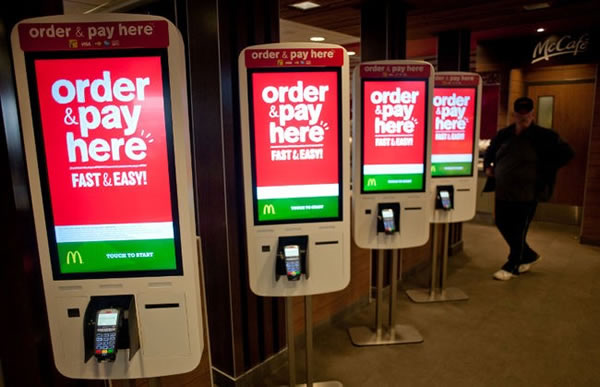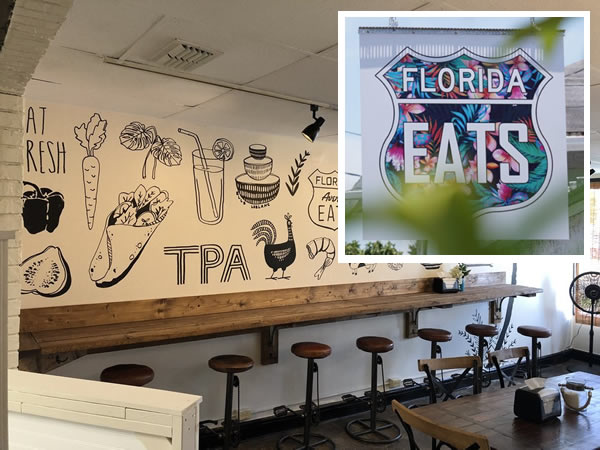McKiosks are popping up in McDonald’s everywhere, but they don’t accept cash
The kiosks are part of renovations that McDonald’s has been pushing stores to adopt, with the lion’s share of the costs being paid by the franchisees. Business Insider reports that many restaurant owners have had to shell out as much as $750,000 per store for these upgrades.
Given that they make a considerable portion of McDonald’s target markets, the “unbanked” — people without a bank account or debit or credit card — account for about 6.5% of U.S. households. That’s 8.4 million people.
Many businesses are going cashless — here are the pros and cons

It’s not just big businesses that are going cashless. Even small mom-and-pop and hipster establishments (including Florida Eats, which recently opened on my neighborhood — and then closed soon after, despite being popular) are no longer accepting cash.
There are a number of reasons for going cashless:
- People buy more when paying with a card. Given the number of people who say they’re not “math people”, the abstract nature of paying with a card, versus the more concrete nature of handing over bills to a cashier, means that the amount paid seems less “real”.
- It makes accounting easier. If you’ve ever worked at a cash register, you know the pain of dealing with the amount in the cash drawer not lining up with the amount shown on its printout. Going cashless eliminates this problem: every transaction is properly accounted for.
- It’s convenient for both payer and payee. They’re no counting bills or change. Retailers report that it speeds up transactions, which increases throughput (the number of transactions you can do in a given amount of time).
- Cash makes you a target. Having to deposit a large amount of hard-to-trace currency at the end of each day is an opportunity for criminals. There are also risks in letting your employees deal with cash, especially in larger amounts.
There are downsides to going cashless:
- You’re going to pay credit card fees. These can be as high as 4%. Worse still is the fact that it doesn’t cost the banks that much to process credit cards — they’re just charging that rate because they can.
- You’ll lose some customers. Remember that 6.5% of people in the U.S. are “unbanked”, and if they make a significant portion of your customers and you don’t take cash, they’ll take their money elsewhere. Even among people with bank accounts, there are people who use cash for reasons such as privacy (which I’ll cover in a moment) or as a money management technique (one example: finance advisor Dave Ramsey’s envelope system).
- When the system goes down, how will you collect money? There are workarounds, and all of them are a pain.
Why I pay for fast food with cash: Data mining

I’m not a regular fast food customer, but there are times when it’s unavoidable. When that happens I pay in cash only, and it’s for an increasingly important reason: so that insurance companies can’t find out.
Companies are increasing their reliance on data mining for all sorts of things (that’s why I’ve been sharpening my Python and Jupyter Notebooks skills), including reducing risk. Insurance companies, whose entire business model is based on betting when you’ll die or get robbed, are gathering as much data about you as they can, which includes your credit card purchase history. That’s why any fast food purchase I make is done with cash.
I got the idea from Kevin Pledge of Toronto-based Insight Data Solutions:
Insurers’ interest in data mining will only grow, says Kevin Pledge, the boss of Insight Decision Solutions, an underwriting-technology consultancy based near Toronto... Insurance firms will also analyse grocery purchases for clues about policyholders, he predicts. But that raises some sticky questions about privacy. Mr Pledge himself has begun to forgo his supermarket loyalty-card discount on junk food and pay for his burgers in cash. Promising as data mining is, much will depend on how regulators, and consumers, react.
I’m not so worried about my grocery purchases — we cook, so we tend to buy ingredients rather than pre-packaged food, and we don’t buy much junk food. I do have a gym membership (and I actually go at least a couple of times a week) but I’ve been toying with the idea of getting a subscription to a fitness magazine, if only to improve my insurance risk profile.